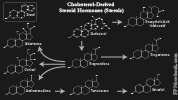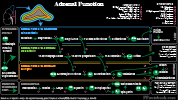II. Definitions
-
Cytokine
- See Cytokine
- Short-range, cell-released molecules that influence the same cell (Autocrine) or nearby cells (Paracrine)
- Autocrine Communication
- Cytokines that influence the same cell that released the molecule
- Paracrine Communication
- Cytokines that diffuse to influence nearby cells
- Endocrine Glands
- Glands that secrete hormonal agents that act systemically
- Contrast with exocrine glands (e.g. Salivary Glands) that secrete molecules locally into ducts
- Hormones
- Molecules secreted by endocrine organs, and carried by the vascular system to influence cells at distant sites
- Hormones may be Proteins (e.g. TSH), Amino Acid derivatives (e.g. Thyroxine) or steroid rings (e.g. Progesterone)
- Hormones act at specific receptors on cell membranes, in the cytoplasm or within the cell nucleus
- Each Hormone may act at multiple different receptors with different effects (e.g. Epinephrine at a1, a2, b1, b2; Histamine at h1-4)
- Hormones may modify enzyme synthesis or activity, or affect other cellular function (e.g. cell membrane permeability)
III. Physiology: Hormonal Activity
- Polypeptides (e.g. Epinephrine)
- Steroid Hormones (e.g. Progesterone)
- See Steroid Hormone Pathway
- Bind cytoplasmic receptors to form molecule complex
- Complex enters nucleus to influence Protein transcription
- Amino Acid Derivatives (e.g. Thyroxine)
IV. Preparations: Hypothalamus and Pituitary Hormones
-
Hypothalamus
-
Corticotropin Releasing Hormone (CRH, CRF)
- Stimulates anterior pituitary release of Adrenocorticotropic Hormone (ACTH)
-
Gonadotropin Releasing Hormone (GnRH, LHRH)
- Stimulates anterior pituitary release of Follicle Stimulating Hormone (FSH)
- Stimulates anterior pituitary release of Luteinizing Hormone (LH)
-
Growth Hormone Releasing Hormone (GHRH)
- Stimulates anterior pituitary release of Growth Hormone
-
Thyrotropin Releasing Hormone (TRH, TRF)
- Stimulates anterior pituitary release of Thyroid Stimulating Hormone (TSH)
- Stimulates anterior pituitary release of Prolactin
-
Somatostatin
- Inhibits anterior pituitary release of Growth Hormone
- Inhibits anterior pituitary release of Thyroid Stimulating Hormone (TSH)
-
Neurotransmitters
- Dopamine released from Hypothalamus inhibits anterior pituitary release of Prolactin
-
Corticotropin Releasing Hormone (CRH, CRF)
- Posterior Pituitary Gland (Hormones produced in the Hypothalamus, released from pituitary)
- Oxytocin
- Stimulates uterine contractions
- Stimulates milk let-down in Lactation
- Antidiuretic Hormone (ADH, Vasopressin)
- Increases renal water reaborption
- Oxytocin
- MIddle Pituitary Lobe
- Melanocyte Stimulating Hormone
- Peptide Hormone promoting Melanin pigment within the skin
- Melanocyte Stimulating Hormone
- Anterior Pituitary Gland
- Prolactin
- Protein synthesized and secreted by Lactotrophs (acidophil cells) in the anterior Pituitary Gland
- Prolactin stimulates milk secretion into the Breast alveoli in pregnancy and Lactation
- Oxytocin stimulates myoepithelial cells to contract, expressing Breast Milk from the nipple
- Stimulated by Estrogen, vasoactive intestinal polypeptide (VIP), Thyroid Releasing Hormone (TRH)
- Inhibition by hypothalamic Dopamine (Prolactin Inhibiting Factor or PIF)
- Human Growth Hormone
- Polypeptide produced in the acidophil cells of the anterior Pituitary Gland
- Triggered by Hypoglycemia (or low Amino Acids) via hypothalamic release of GHRH
- Promotes bone and cartilage growth, Protein synthesis, glycogen storage, Fatty Acid increase
- Adrenocorticotropic Hormone (ACTH)
- Polypeptide synthesized and secreted by Basophil cells in the anterior Pituitary Gland
- Stimulation (releasing factors) include Corticotropin Releasing Hormone (CRH) and stress
- Inhibition by negative feedback loops (Cortisol inhibits CRH and ACTH release)
- ACTH stimulates the Adrenal Cortex to release Cortisol (and to a lesser extent Aldosterone and androgens)
- Thyroid Stimulating Hormone (TSH)
- See Thyroid Physiology
- Thyroid Stimulating Hormone (TSH) is a Glycoprotein synthesized in the Basophil cells of the anterior Pituitary Gland
- Stimulated by Thyroid Releasing Hormone (TRH)
- Inhibited by negative feedback from Thyroid Hormones (T4, T3)
- Thyroid Stimulating Hormone (TSH) promotes all aspects of Thyroid Hormone production
- Increases Iodide uptake and incorporation of Iodine into Thyroglobulin
- Increases lysis into active Thyroid Hormones T4 and T3
- Follicle Stimulating Hormone (FSH)
- FSH is a glyoprotein secreted by Basophil cells in the anterior Pituitary Gland
- Stimulation (releasing factors) is by Hypothalamic Gonadotrophic Releasing Hormone (GnRH)
- Inhibited via negative feedback loop by Testosterone, Estrogens, Progesterone and inhibin
- FSH stimulates ovarian follicle growth (which secretes Estradiol) in women
- FSH stimulates spermatogenesis and sperm maturation within Sertoli Cells in men
- Luteinizing Hormone (LH)
- LH is a Glycoprotein secreted by Basophil cells in the anterior Pituitary Gland
- Stimulation is by Hypothalamic Gonadotrophic Releasing Hormone (GnRH)
- Inhibited via negative feedback loop by Testosterone, Estrogens, Progesterone and inhibin
- LH stimulates ovarian follicles to ovulate and mature into a corpus luteum (produces Estrogen, Progesterone)
- LH stimulates Leydig Cells within Testes to produce Testosterone
- Prolactin
V. Preparations: Adrenal Hormones
- Physiology Images
-
Adrenal Medulla (sympathetic agent synthesis)
- See Sympathetic Nervous System
- See Alpha Adrenergic Receptor
- See Beta Adrenergic Receptor
- Inner structure of the Adrenal Gland
- Functions as a sympathetic Ganglion that releases Sympathomimetics in response to stressors
- Epinephrine
- Primary Adrenal Medulla released Catecholamine (more than Norepinephrine)
- Alpha Adrenergic Agonist Effects
- Vasoconstriction (increased Systemic Vascular Resistance and Blood Pressure)
- Increases Vital Organ Perfusion (myocardial perfusion, cerebral perfusion)
- Decreases Non-Vital Organ Perfusion (splanchnic, intestinal, renal and skin perfusion)
- Beta 1 Adrenergic Agonist Effects (at physiologic doses)
- Increases myocardial contractility
- Increases Heart Rate
- Beta 2 Adrenergic Agonist Effects
- Relaxes Bronchial Smooth Muscle (bronchodilation)
- Stimulates Gluconeogenesis, lipolysis and glycogen breakdown
- Norepinephrine
- Neurotransmitter for all other postganglionic sympathetic Neurons
- Potent Alpha 1 Adrenergic ReceptorAgonist Effects
- Potent arterial and venous Vasoconstriction
- Beta 1 Adrenergic ReceptorAgonist Effects
- Similar potency to Epinephrine
- Increases myocardial contractility
- No Beta 2 Adrenergic Receptor Activity
-
Adrenal Cortex (steroid Hormone synthesis from Cholesterol)
- See Adrenal Gland Physiology
- See Steroid Hormone Pathway
- Outer structure of the Adrenal Gland
- Mineralcorticoids (esp. Aldosterone)
- See Sodium and Water Homeostasis
- See Renin-Angiotensin System
- Increases Sodium retention and Potassium excretion
- Increases water reabsorption from Kidney
- Glucocorticoids (esp. Cortisol)
- Mobilizes available energy sources (Glucose, fats, Amino Acids)
- Increases Serum Glucose by stimulating liver Gluconeogenesis and glycogenolysis
- Increases serum Fatty Acids by promoting lipolysis of adipose Triglyceride stores
- Increases blood Amino Acids by breaking down Proteins (outside liver)
- Antiinflammatory activity
- Inhibit Histamine release
- Inhibit Lymphocyte production
- Stabilize MacrophageLysosomes
- Increases gastric acid production
- Mobilizes available energy sources (Glucose, fats, Amino Acids)
- Androgens
VI. Preparations: Miscellaneous Hormones
- Sex Hormones

- See Menstrual Cycle
- Human Gonadotrophin (HCG)
- Estrogen
- Progesterone
- Testosterone
- Glucose Metabolism
- Gastrointestinal Hormones
-
Thyroid Hormones
- Thyroxine (T4)
- Triiodothyronine (T3)
- Calcium Metabolism
- Cardiac Hormones
- Atrial Natriuretic Factor or Peptide (ANF, ANP)
VII. Anatomy: Endocrine Components
- Adrenal Anatomy
- Thyroid Anatomy
- Parathyroid Anatomy
- Pituitary Anatomy
- Testes Anatomy
- Ovary Anatomy

